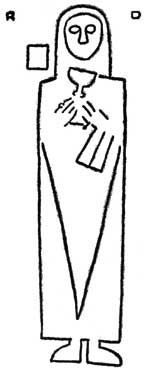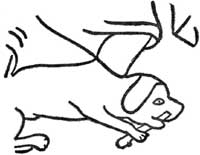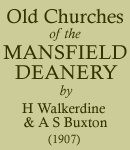< Previous | Contents | Next >
Selston (continued)
When the Domesday survey was made, a church existed at Selston, and probably there was one in earlier times, for three acres of meadow were allotted to it in Saxon days. Let us turn to the plan of the church. It consists of nave, chancel, north and south aisles, tower, south porch, north and south chancel chapels, and vestry. Probably towards the end of the reign of Henry II., it became necessary to enlarge or repair the edifice, and the present northern nave arcade was built. It consists of four bays, semi-circular arches of two orders; the columns are round, and the ornament, which is partly of palm leaf, some heads, and a type of foliage bearing a slight resemblance to Early English, is somewhat rude. There are pointed bowtells on the responds. The bases of this arcade are cut away. Coming to the reign of the First Richard or John, the south arcade, chancel, chancel chapel, and south porch were built. Like the north this arcade consists of four bays, the arches being semi-circular in form with two orders plain chamfered, and the columns round. The bases here are good. The capitals are moulded, and the east respond is octagonal. Low and semi-circular is the chancel arch, supported by two corbels, the south having much more of the Early English character than the north. The Chapels are connected with the chancel by two arches, the columns supporting them being of the same period as the south nave arcade. Of the same date is the porch, with its inner and outer doors. The latter is plain, devoid of moldings, and the arch consists of two plain chamfered orders. Curiously carved are the imposts, the western one, with rude leaves and heads, being the richer. The inner door has three shafts either side, and pointed bowteil mold used round the arch. On the east jamb is carved a row of dog tooth ornament. The south side of the chancel contains an early Geometric window, and a fragment of tracery of the same date was discovered in the recent restoration. This has been used in the east window of the south aisle. These seem to point to the fact that in the reign of Edward I. a further alteration took place, windows of the Early Decorated style being here and there inserted, supplanting the lancets of the former period, with this exception, apparently. Selston remained unchanged during the seventy years or so that the Decorated Gothic architecture remained in England. In the fifteenth century more building took place, the tower being entirely rebuilt a clerestory added, a new roof put upon the church, and east windows inserted. The tower has a west door, two corner buttresses, a three-light west window, belfry windows of two lights, and is surmounted by a battlement devoid of corner pinacles. On the battlement is carved a shield bearing apparently two roses and a bend with T & S on the sides, and the letters I & M (Jesu and Mary). Before the restoration it was very apparent, from the exterior that considerable alterations were made in the seventeenth century, but the only relic of this time now remaining is the square-headed door, formerly the priest's door on the south side of the chancel and now converted into a vestry door. It has the date 1633 on the lintel.

Incised slab in the chancel.
Still many remnants of the old church have been preserved. Quite a number of incised slabs and quaint carvings have been built into the walls. As showing how Selstonian churchmen sought after comfort we might mention that before the restoration an examination of the columns showed that holes had been cut in them to allow for the insertion of a hat rail. At the exterior of the building are to be noticed, immediately beneath the east window, several pieces of what has once been part of a fine alabaster tomb. It is impossible to form any definite opinion as to what it has actually represented, but from the markings still observable, we feel justified in suggesting that it may have been the tomb of a priest. The ornament is certainly ecclesiastical. There is in the east wall, too, a curious little square cut, but for what purpose tnis can have been used it is impossible to say. But to return to the interior. On the north side of the chancel is a fine alabaster monument erected to the memory of a Willoughby, and also in the chancel is a slab of a priest in vestments, holding a chalice in sanctuary. Above the latter is the Willoughby Knights helmet and banner. On the tomb is the following inscription:—"Here lieth William Willoughby, Esq., sonne and heire of Sir Rotherham Willoughby, Kt., sonne of Sir William Willoughby, Kt., and Dame Anne, his wife, one of ye daughters of Sir Richard Wortley, Kt., and of Elizabeth, his wife. Countess of Devon. He married Elizabeth, one of the daughters of Timothy Pusey, Esq., who made this monument in memory of her husband, who by her had foure children. He was aged 21 and three-quarters, and died XII. day of November, 1630."
Above the monument at the entrance to the chancel is a slab fixed containing this somewhat extraordinary panegyric:
''To the death of that well deserving gentleman who departed this life March 12, 1630, interred beneath this monument doth lie as great perfection as with men good die, which more ennoble him than birth or blood, since its less worthy to be great than good. His noble ways blazoned his progeny, and proved him a right, true born Willoughby. If ere thou knew'st him living, drop a tear, not cause he's dead, but cause we want him here. Whose goodness gain'd him love, true worth renown, good life, good end, and that good end a crown—of glory. In the heavens which he inherits in right of faith and all his Saviour's merits. Yet left he ere he went behind a pair of female babes, besides his infant heir, a hopeful imp, a right young Willoughby in whom love portrayed my world's bright eye, his father's gentle parts. Of our others, one of those fair virgin babes, since from us gone to bear her father company, the other surviving the joys to wait upon her sweet mother whose virtues merit long to enjoy in this world all that's good, in other world all bliss."
Writing of the custom of placing banners, pieces of armour, etc., in churches, Bloxam says, these were carried at the funeral by the heralds. As far back as 840 in the ecclesiastical law of Kenneth, King of Scotland, there was an injunction that at the funerals of illustrious men amongst other ceremonies, was this: A Knight sitting about a white horse should bear the arms of the deceased and precede the funeral procession, and that on his arrival at the church he was to go forward to the altar and offer to the priest the arms and horse of the illustrious dead.
William Beauchamp, father of the first Earl of Warwick, in the 52nd year of the reign of Henry III. "left his body to be buried, and ordered that his horse, encased in iron, should be left according to custom, with military trappings."
Sir Walter Caxey, Kt., in 1294, left his body to be interred, but bequeathed to the brethren of the Priory 10 marks of silver in lieu of his armour which was to be borne before his body and afterwards handed to his son. But the horse which carried the armour should go to the friars. From the 14th to the middle of the 17th century pageantry at funerals increased, but from the reign of Henry VII. to the time of Charles, the marshalling of funeral processions formed no small part of the business of the heralds. At this period also the funeral achievements of the deceased, his helm, crossed swords, spurs, targe, coat armour, tabard, and banner were often affixed over his tomb or suspended from a wall near therto. After the civil wars of the 17th century this custom fell into disuse, with some few exceptions, and may now be only partially observed in the painted hatchments which are still sometimes fastened to the walls of churches.
In the tower at Selston hangs the Royal arms, which once hung, probably, on the rood screen or chancel arch.

Quaint carving on the exterior of the north aisle.
Other mural monuments in the church are as follows:—"In memory of Rev. Robert John Wm. Wright, 30 years, vicar of this parish, who died 1887, aged 84 years. Also his wife, aged 67, who died April 4th, 1878." This was fixed in the chancel. On the opposite side is a stone to the memory of Eliza Maria Wright, second daughter of the Rev. R. J. W. Wright. Others are to the memory of "George Wales Laverick, Pye Hill House, who died 1889, aged 52 years. "William James Blake, who for 23 years was churchwarden, and who died at the age of 75. in 1894." In the south porch there are slabs to the memory of two vicars, the Rev. F. Churchill and I. Pepper.
Robert Martyn was buried in the chancel, and William Martyn in the choir; Francis of the same name in the church, and the bones of the Rev. Richard Martyn, vicar in 1525, were deposited in the choir.
Here are a few extracts from the registers:
Ffrancis Cheetham, ye sonne of Ffrancis Cheetham, of Bagthorpe, begot by Anne, his wife, born ye 1st of Nov., baptised at his house in a great snow, ye 30th Nov. 1658.
A man child born to John Tibshelf begot by Ellen, the wife, born ye 14th day of Nov., 1659, buried ye same day, being ye 14th of Nov., 1659.
1703 Nov. 12th, Edward, son of Jonathan and Mary Clee, born, and baptised by a Dissenting Teacher in a Barn on Dove Green.
1707, Oct. 23, John, son of John and Sarah Horsly, born, not baptised, the parents being Quakers, May 15th, 1709.
John Selby, born and baptised at the barn on Dove Green, by a Dissenting Teacher.
Between 1703 and 1806 there are recorded 31 baptisms, as having been performed in a barn.
William Grainger, "a piper and digger," is amongst the burials, and a curious entry under marriages in the year 1728 is—Thomas Horot, a sojourner, and Grace Roy, of the parish of Alfreton.
John Cooper, "my good friend and old neighbour," was buried on Dec. 24th, 1673, writes the vicar.
Notitia Parochialis has the following return from Selston: The tithes of the vicarage of Selston are impropriated to the Lady Dixie, liyeing in the parish of Selston. The church is endowed only with small tithes, the yearly value of which is about £7 per annum. The advowson belongs to Lady Dixie.
We cannot conclude with a better epitaph than that to be found engraven on the stone in the churchyard which marks the resting place of Dan Boswell, the "King of the Gipsies":—
I've lodged in many a town,
I've travelled many a year,
But death at length has
rought me down To my last
lodging here.
There are six bells, the following of which is a description of them:—
Fleur de lys. Gabriel 1 yr." (Black letter.)
"Church council bell." For this church restored give thanks to the Lord, 1905." (Roman lettering).
"St. Helen's Bible Union bell." "Let my music be heard in praise of the word, 1905." (Roman lettering).
"Children's bell." "The children did well and purchased this bell, 1905." (Roman lettering.)
"Sweetly tolling men do call to taste on meats that feed the soul, 1622." G. Oldfield's mark, and on a shield quartered P.H. in top quarters, and branches in bottom. (Black letter.)
"God save his church, 1704." Francis Cheetham, William Woods, churchwardens." (Roman lettering.)
All the 1905 bells were cast by Barwell. of Birmingham, who has re-hung the whole peal. About the middle of the eighteenth century the church possessed but two bells, and the living was of "clear yearly value £6, 7s., and £20." When the Prior of Beauvale was patron it was ten marks, and in the King's Books it was entered as £5.
